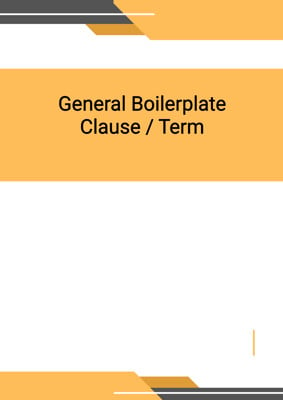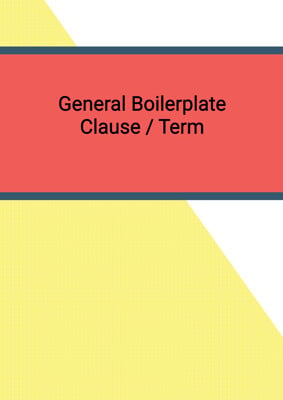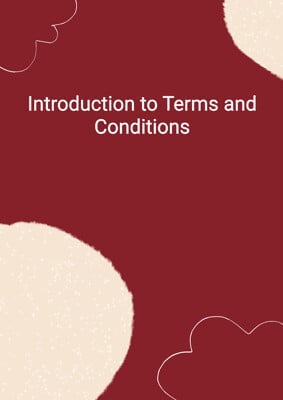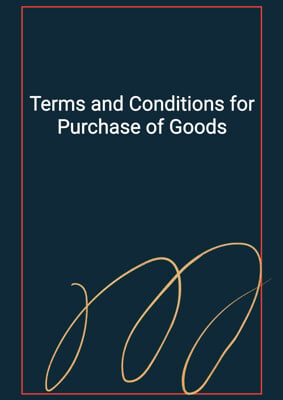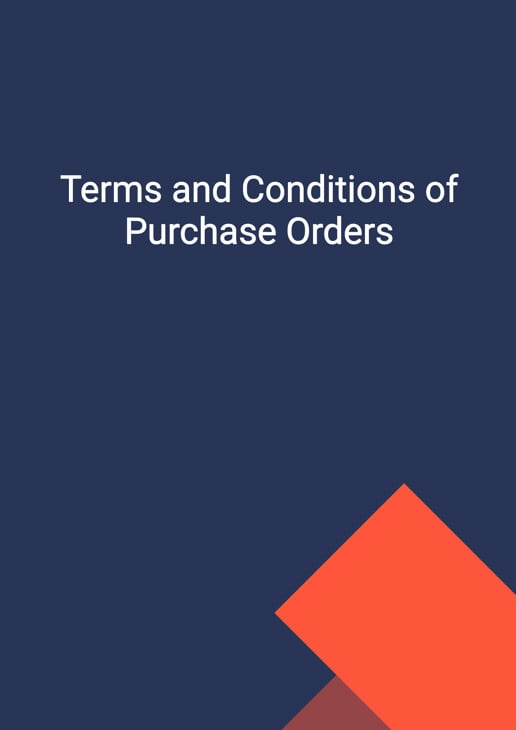
Terms and Conditions of Purchase Orders
Buyer
This is a set of Standard Terms and Conditions (Long Form) for the purchase order providing a framework for individual sale and purchase transactions drafted in favour of the Buyer. The parties are deemed to have accepted them by transacting without signing. The basic structure of the agreement includes: notification, delivery, warranty, indemnification, compensation and etc.
How to Tailor the Document for Your Need?
01
Create Document
Click "Create Document" button and the document will be prepared with your account details automatically filled in.
02
Fill Information
Please fill in any additional information by following the step-by-step guide on the left hand side of the preview document and click the "Next" button.
03
Get Document
When you are done, click the "Get Document" button and you can download the document in Word or PDF format.
04
Review Document
Please review the document carefully and make any final modifications to ensure that the details are correct before publication / distribution.
Document Preview
Document Description
The document titled 'Terms and Conditions of Purchase Orders' is a crucial document that outlines the terms and conditions that both the account job company ('company') and the seller must agree to when accepting a purchase order. This document serves as a legally binding agreement between the two parties and ensures that both parties are aware of their rights and responsibilities.
The entire document is divided into multiple sections, each addressing a specific aspect of the purchase order process. The first section, titled 'Vendor Notification,' emphasizes the importance of the seller notifying the company within a specified time frame if they do not accept a purchase order. This section also highlights the need for the seller to acknowledge and comply with all the terms and conditions stated on the purchase order.
The second section, 'Delivery and Price,' focuses on the seller's agreement to deliver the goods according to the purchase order's specifications and at the agreed-upon prices. It also allows for lower prices and more favorable terms if they are available at the time of shipment.
The third section, 'Warranty,' highlights the seller's warranty obligations. It states that all goods and services ordered must comply with federal, state, and local laws and regulations. The seller also warrants that the goods will be fit for their intended use and of merchantable quality. The company reserves the right to reject inferior quality goods or withhold payment for such goods.
The fourth section, 'Indemnification,' outlines the seller's responsibility to defend, indemnify, and hold the company harmless from any claims, damages, or expenses arising from the goods or services provided by the seller. This includes claims related to product liability, intellectual property infringement, and false warranties.
The fifth section, 'Reservation of Rights,' states that the company can exercise its rights at any time if a breach of the conditions continues. The company can deduct excess transportation charges or cancel the purchase order in case of unforeseen circumstances that affect its operations.
The sixth section, 'Time is of the Essence,' emphasizes the importance of timely delivery. The seller agrees to reimburse the company for any costs resulting from late delivery and acknowledges that the company may reject or cancel any shipment that will not be delivered by the agreed-upon date.
The seventh section, 'Mitigation of Damages,' allows the company to mitigate its damages if it determines that it will run out of stock due to the seller's inability to deliver goods on time. The seller agrees to reimburse the company for any expenses caused by non-compliance with the terms of the purchase order.
The eighth section, 'Quality of Goods and Returns,' specifies that all goods shipped by the seller must be new and of first quality. The seller agrees to reimburse the company for any returns of goods and accepts the company's account of how much credit is due. The company is not responsible for notifying the seller of returned goods and may liquidate the returns as deemed appropriate.
The ninth section, 'Compensation for Returned Goods,' requires the seller to compensate the company for all goods returned by customers, including those supplied by previous vendors. The seller is responsible for all shipping, storage, and handling charges incurred by the company for returned goods.
The tenth section, 'Reimbursement,' states that the seller must reimburse the company for all attorneys' fees and expenses incurred due to the seller's failure to indemnify and hold the company harmless. The company may withhold payment to cover any funds at risk in case of a lawsuit or claim.
The eleventh section, 'Insurance Requirement,' requires the seller to make the company an additional insured under its liability insurance policy. The seller must provide written verification and a complete copy of the policy upon request. The seller's failure to name the company as an additional insured does not relieve the seller of its duty to indemnify the company.
The twelfth section, 'Governing Law and Severability,' states that the terms and conditions of the document shall be interpreted and construed solely by the laws of the jurisdiction state. The invalidity or unenforceability of any part of the conditions does not affect the validity of other provisions.
The thirteenth section, 'Remedy,' encourages the parties to resolve any disputes through direct communication. If unable to resolve the dispute, the parties agree to submit to final and binding arbitration. The provision specifies the types of claims subject to arbitration and the rules governing the process.
The fourteenth section, 'Waivers; Modification,' clarifies that the failure to insist on strict compliance with any terms or conditions does not waive such terms or conditions. Any modifications to the agreement must be made in writing and executed by both parties.
The fifteenth section, 'No Partnership or Authority,' emphasizes that the agreement does not create an employment, partnership, or agency relationship between the seller and the company. The seller is an independent contractor, and the company is not responsible for withholding taxes or providing employee benefits.
The sixteenth section, 'No Assignment,' prohibits the seller from assigning or transferring its obligations without the company's prior written consent. Any unauthorized assignment or transfer is voidable at the company's discretion.
The seventeenth section, 'Termination,' allows the company to terminate the agreement or cancel a purchase order under certain circumstances, such as the seller's bankruptcy, insolvency, or substantial violation of the agreement's provisions.
The eighteenth section, 'Electronic Signature,' recognizes electronic signatures as valid and binding. The parties agree that electronically transmitted versions of the agreement constitute a binding agreement.
The document concludes with a statement that any terms or conditions on forms or documents submitted by the seller are superseded by the terms and conditions of the purchase order and the agreement.
How to use this document?
To effectively use the 'Terms and Conditions of Purchase Orders' document, follow these steps:
1. Familiarize yourself with the document: Read the entire document carefully to understand its importance and the obligations it imposes on both the company and the seller.
2. Ensure acceptance of purchase orders: As a seller, promptly notify the company within the specified time frame if you do not accept a purchase order. Comply with all the terms and conditions stated on the purchase order and in the document.
3. Deliver goods as specified: Fulfill your obligation to deliver the goods according to the purchase order's specifications. Adhere to the agreed-upon prices or offer lower prices and more favorable terms if available.
4. Comply with laws and provide warranty: Ensure that all goods and services ordered comply with federal, state, and local laws. Warrant that the goods are fit for their intended use and of merchantable quality. The company reserves the right to reject inferior quality goods.
5. Defend and indemnify the company: Take responsibility for defending, indemnifying, and holding the company harmless from any claims, damages, or expenses arising from the goods or services provided. This includes product liability, intellectual property infringement, and false warranties.
6. Understand the company's rights: Be aware that the company can exercise its rights at any time if a breach of the conditions continues. This may include deducting excess transportation charges or canceling the purchase order in case of unforeseen circumstances.
7. Ensure timely delivery: Reimburse the company for any costs resulting from late delivery of goods. The company may reject or cancel any shipment that will not be delivered by the agreed-upon date.
8. Handle returns and reimbursements: Ship new and first-quality goods to the company. Reimburse the company for any returns, including shipping, storage, and handling charges. Accept the company's account of how much credit is due.
9. Compensate for returned goods: Agree to compensate the company for all goods returned by customers, including those supplied by previous vendors. Take responsibility for all associated expenses.
10. Reimburse for legal fees and expenses: Reimburse the company for all attorneys' fees and expenses incurred due to failure to indemnify and hold the company harmless. Understand that the company may withhold payment to cover any funds at risk.
11. Fulfill insurance requirements: Make the company an additional insured under your liability insurance policy. Provide written verification and a complete copy of the policy upon request.
12. Understand governing law and dispute resolution: Recognize that the terms and conditions are interpreted and construed solely by the laws of the jurisdiction state. Attempt to resolve any disputes through direct communication, and if necessary, submit to final and binding arbitration.
13. Comply with the agreement: Adhere to the terms and conditions of the document. Understand that any modifications must be made in writing and executed by both parties.
14. Maintain an independent contractor relationship: Acknowledge that you are an independent contractor and not an employee, partner, or agent of the company. Understand that the company is not responsible for providing employee benefits.
15. Seek consent for assignment or transfer: Obtain the company's prior written consent before assigning or transferring your obligations, accounts payable, or receivable.
16. Avoid termination: Take necessary measures to avoid termination of the agreement or cancellation of a purchase order. Correct any conditions that may lead to termination within the specified time frame.
17. Utilize electronic signatures: Use electronic signatures when executing the agreement. Understand that electronically transmitted versions of the agreement are considered binding.
18. Supersede other forms or documents: Recognize that the terms and conditions of the purchase order and the agreement supersede any terms or conditions on forms or documents submitted by you.
By following these steps, you can effectively use the 'Terms and Conditions of Purchase Orders' document and ensure compliance with its provisions.
Not the right document?
Don’t worry, we have thousands of documents for you to choose from:





